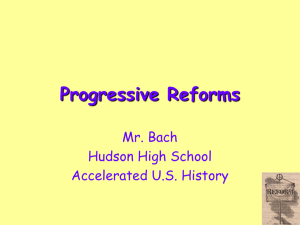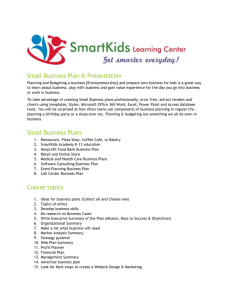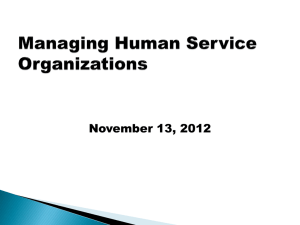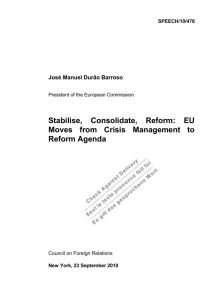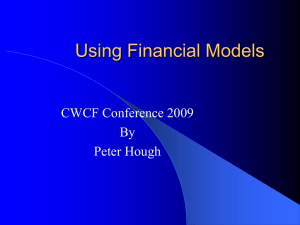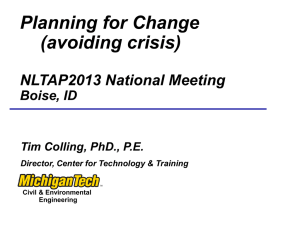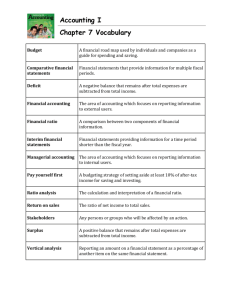Comparative Budget Reform _Liberia vs - PFM blog
advertisement
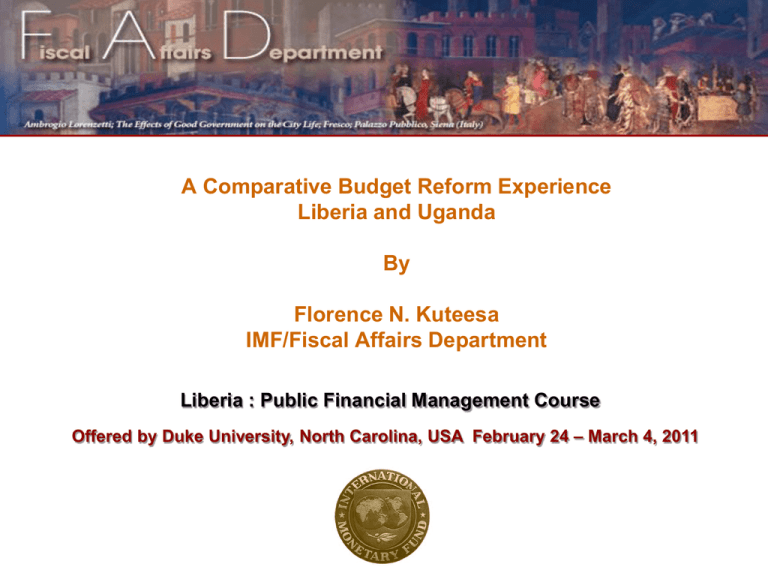
A Comparative Budget Reform Experience Liberia and Uganda By Florence N. Kuteesa IMF/Fiscal Affairs Department Liberia : Public Financial Management Course Offered by Duke University, North Carolina, USA February 24 – March 4, 2011 Content • Focuses on post-conflict budget reform experiences for both countries. • A glance at select socio-economic indicators • Post-conflict PSR and PFM Reforms • Evolution of budget reforms • Have the budget reforms been effective? a comparative analysis of PEFA scores. • What are the emerging lessons? A glance at select socio-economic indicators……. Indicator Area Liberia 2003 2011 (start of new era) (eight yrs later) 11,370 sq. kms Uganda 1986 1994 (start of new era) (eight yrs later) 236, 040 sq.kms 2011 Population 2.5 m 3.3m 13.0m Inflation rate GDP growth rate 5.0 4.5 Highest 200 % -31.3 8.8 Negative US$195 Less than US$150.00 11.9 25 6.8 % (91/92) 10 12.8 14.5 25 21.6 (91/92) 16.9 21.2- 17.8 NS GDP per capita Domestic Revenue %GDP Governme nt Exp % GDP 16.0m 32.4m Single digit 6.5 6.2 US$500 Post Conflict: Select Public Service and PFM Reforms Liberia 2003 Political/Governan ce System Public service reforms Constitution and PFM legislative Decentralization Budgetary Institutions Revenue Mobilisation 2011 Multiparty 21 Ministries and 15 Counties. Constitution, PFM Act 2009), Financial Regulation(2009) A long-term reform Budget Dept, MoF & MPEA MoF & Budget Committee MPEA Still Departments in MoF? Uganda 1994 1986 One Party 32 ministries with 329, 000 civil servants 1964 with amendments MoF & MoPED Various Departments in MOF 2011 Multiparty 22 ministries Civil servants: 157,000(1995) Capacity building Constitution 1995 228,000(2005) Political 33 districts Fiscal Dec (1996) 110 districts PFM Act 2003 Merged since 1992 Creation of Revenue Authority (92) URA Post Conflict: Select Budget Reforms Key Reform areas Spending Priorities Public Investment Program Medium-term fiscal framework MTEF Liberia 2003 Uganda 2010/11 PRS (2008) A system for appraisal & selection of PIP(2010) Public Expenditure 1993/4 Core &non-core programs PIP (wish-list) 1998- 2011 PEAP(1997) Rolling PIP& Database (1992) Development Planning manual MTFF(2009) MTFF since 1992 Reform strategy being developed. Fiscal Decentralization Budgeting Approach 1986 Aggregates- wages, non-wage recurrent, development (92) No direct transfers Incremental and line item-based for recurrent Health and Education Block grants( 94) Incremental and line item-based for recurrent Annual PER by World Bank Disaggregated by LM & broad economic exp items All grants(1998) Policy/output informed budgeting (98) Automation of OBB(2009/10) PER since 96- transfers, sector-specific or cross- Post Conflict: Select Budget Reforms Key Reform areas Liberia 2003 Uganda 2011 1986 1994 Integration of Aid into the Budget and MTEF Draft Aid Coordination Policy Openness of Budget process Budget calendar revised Only budget discussions conducted by MoF/MPED Budget Documentation Budget Framework Paper Budget Framework Paper © Background to Budget(P), Ministerial Policy Statements(P) Planning & budgeting capacity ????? 1998- 2011 Partnership Principles ( 2001). Integrating aid resources into the medium-term fiscal framework and MTEF Profession of economist & statisticians cadre. Strengthening planning units Budget Calendar with consultations and PERs (98) Communication Strategy Citizens Guide to Budget BFP(N&S) BTTB Planning and budgeting manual in 2004 Evolution of PFM Reform in Uganda: Major Milestones Macroeconomic Stabilization Investment & Infrastructure Poverty Reduction Enhanced accountability Automation Poverty/results focused Budgeting Enhancing fiscal discipline 1986 1996 2005 1986-1996 •Reduction of double digit inflation to single digit 1996-2005 2010 2005-2010 •Poverty Reduction Action Plan (97) •Continued roll out of IFMIS. •Creation of Uganda Revenue Authority • Medium-term Expenditure Framework and budget reforms • Automation of the Output based budgeting(OBB) •Merger of MoF and MPED in 1992. • Fiscal Decentralization •External debt management strategy. • IFMS introduced all LM & few LGs •Public Investment Program mainstreamed into Budget • Budget Act 2001 •MTFF and Cash budgeting • Independent Auditor General •Strengthening of planning and budgeting function/cadre. • Treasury Department upgraded to Accountant Generals office • PFAA 2003 •Procurement Law. Regulations, Institutional Development Have the budget reforms been effective? Budget Credibility Performance Indicator Liberia 2008 Uganda 2005 2008 PI 1 Aggregate expenditure outturn compared to original approved budget B B B PI 2 Composition of expenditure out-turn compared to original Approved budget. D C C PI 3 Aggregate revenue out-turn compared to original approved budget. A A A PI 4 Stock and monitoring of expenditure payment arrears D+ D D+ 9 Have the budget reforms been effective? – Policy-based budgeting Performance Indicator Liberia 2008 Uganda PI-11 Orderliness and participation in the budget process B 2005 C+ 2008 C+ PI-12 Multi-year perspective in fiscal planning, expenditure policy, and budgeting D+ B C+ PI-24 Quality and timeliness of in-year budget reports C D C+ No score C+ D D-2 Financial Information provided by donors for D budgeting & reporting on project and program aid D+ C D-3 Proportion of Aid that is managed by use of national procedures. C D Donor practices D-1Predictability of donor funds D 10 Have the budget reforms been effective? Comprehensiveness &Transparency of the budget Performance Indicator Liberia 2008 Uganda PI 5 Classification of budget C 2005 B 2008 A PI 6:Comprehensiveness of information included in budget PI 7 Extent of unreported Government operations. C B A D+ C D+ PI 8 Transparency of intergovernmental fiscal relations No score C D+ PI -9 Oversight of aggregate fiscal risk from other public sector entities D D C PI- 10 Public Access to key fiscal information C B B 11 Lesson 1: Inadequate coordination of external resources undermines credibility of the budget…... • A wide range of donor interests & expectations are difficult to harmonize at national level: • Confusing and conflicting: MDGs versus poverty goals • Costly and not sustainable ( project implementation units) • Numerous conditionalities & obligations prevent compliance with legitimate rules, processes, accountability • Fragment budget decision making(dual budgeting) • Ultimately undermining optimal allocation of resources within the MTEF. • Policy framework, including guidelines, to mainstreaming aid management into the budget process is an urgent priority Lesson 2: Enhancing the credibility of the Budget requires a holistic approach ………. Ownership Agreement on Priorities: Translation of political aspirations and developments needs into policies, actions & budgetary policies Assurance Confidence: Link policy making and budgeting MTEF and Budget reflect agreed priorities. Ouputs and Impacts: Conversion of expenditure into public goods. Demonstrated impact as desired. Effective monitoring, reporting and oversight Trust Enhanced predictability of resources. Minimise deviation between appropriation and expenditures Better use of available cash. Lesson 2: What are the common challenges to a holistic approach ?(ctd) • Political ownership/consensus of priorities is undermined by the: – Multiple national development plans( PRSP, Visions, MDGs) – Numerous institutional mechanisms without effective coordination. – Inadequate engagement of policy makers. • Translation of policies into resource allocation is challenged by the: – – – – Multiple strategic plans driven by different stakeholders Lack of or poor costing of on-going or new policies Ambitious targets not guided by realistic resource ceilings Budget classification hinders meaningful analysis of resource allocation. Lesson 2: what are the common challenges to a holistic approach……..? (ctd) • Enhanced predictability constrained by: – Poor commitment control – Poor cash management – Emergencies and political directives. • Monitoring, reporting and accountability is undermined by – Too many mechanisms/systems by different stakeholders – Hardly influence decisions – Overload the spending agencies. – Reports neither consistent nor provide strategic direction. Lesson 3: Reforming the functionality of a Budget Directorate • Ownership, commitment and technical competence • Understanding of the reform agenda: – Clarity on reform concept and principles, institutional roles etc – Intensive sensitization program (medium-term). – Simplified guidelines and instruments, training materials. – Training strategy should be mainstreamed within budget process. • Coordination with relevant departments in MoF and MPEA. • Technical support and mentoring sectors/LMs. • Strengthen the “challenge function”: strategic allocation and use of public funds, economy, efficiency & effectiveness (impact) • Capacity enhancement in policy analysis (budget and sector specific), program design, appraisal and evaluation etc • Streamline the institutional set-up of the Directorate, including execution of duties. In conclusion, a reform is a long drive that requires….. • Steady and focused driver: strong and competent leadership • A map: a shared vision including SMART deliverables for a credible reform • Keep to the road: A mutual commitment to work consistently within a coherent framework (guidelines and incentives). • New passengers : will be motivated and board at various stages. 17 Thank you
